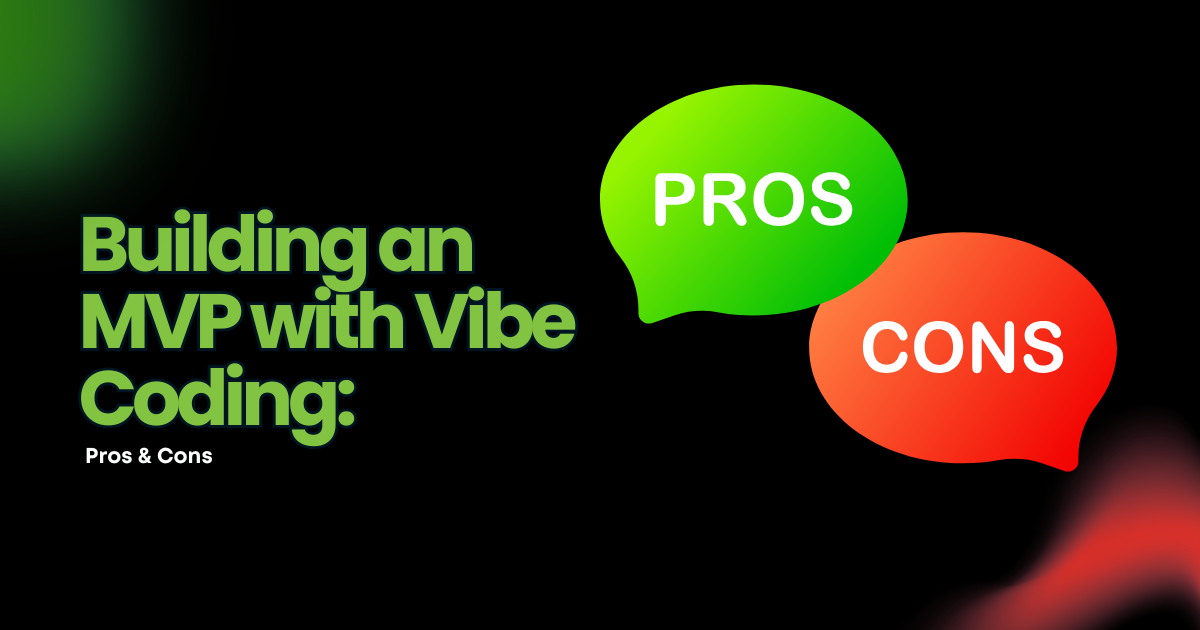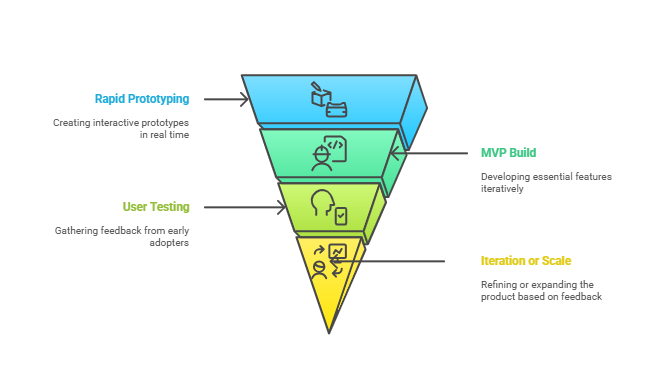
Launching a product in today’s competitive landscape demands speed, adaptability, and sharp focus on customer needs. That’s why many founders embrace the concept of a Minimum Viable Product (MVP). It allows them to validate ideas before investing heavily in full-scale builds.
A newer way of approaching this process is building an MVP with vibe coding. Instead of sticking to rigid development timelines, vibe coding emphasizes flow and agility, helping teams accelerate the MVP development lifecycle. But while it promises speed and collaboration, it also introduces risks worth considering.
This article explores how to build an MVP using vibe coding, the pros and cons of the approach, and where it fits in modern product development.
Lets first start with why use vibe coding for building your MVP.
Why use vibe coding for building an MVP
Speed and learning are everything at the earliest stage. Vibe coding leans into both, giving founders a sharper path from idea to first user signal.
● Reach signal faster: Turn sketches into interactive flows in the same session and put something clickable in front of users within days, not weeks. Early signal cuts uncertainty and keeps scope honest.
● Tighter feedback loops: Founder, designer, and engineer work in one live environment. Decisions happen in context, which reduces back-and-forth and rework.
● Lower upfront cost: Less ceremony, fewer handoffs, and lightweight specs mean more time spent shaping the actual product. You learn what matters before paying to harden what does not.
● Iterate in small, safe slices: Ship tiny changes behind flags or mocks, test with a small cohort, then keep what works. This protects momentum while you discover the right feature set.
● Stronger product intuition: Seeing the interface evolve in real time helps teams notice friction that documents miss. You catch UX issues while they are still cheap to fix.
● Better timing to market: When windows are narrow, being first with a credible slice matters. Vibe coding helps you ship the version that answers one job clearly and then refine with real usage.
Building an MVP with Vibe Coding: Step by Step

1. Define the Core Problem
Before writing a single line of code, founders need clarity on the problem they’re solving. In vibe coding sessions, this step becomes collaborative, with stakeholders and developers quickly aligning on the core features to prioritize. This ensures the Minimum Viable Product targets real pain points instead of bloated feature lists.
2. Rapid Prototyping
Vibe coding shines here. Instead of traditional sprint planning, developers can create interactive prototypes in real time. Founders get to see product flow instantly and provide feedback during the session itself. This speeds up the early phase of building an MVP, reducing communication gaps.
3. MVP Build
Once prototypes are validated, the team shifts focus to developing the must-have features. With vibe coding, progress happens in smaller, iterative chunks, giving the flexibility to test and refine features faster than with conventional development.
4. User Testing
The MVP is then released to early adopters. Since vibe coding allows for immediate adjustments, feedback loops are tighter. This enables startups to address usability issues or add minor improvements almost instantly, strengthening the learning cycle central to the Lean startup methodology.
5. Iteration or Scale
Depending on feedback, the product either evolves through continuous iterations or prepares for scaling. At this stage, teams often need to balance vibe coding’s flexibility with more structured practices to ensure stability and scalability.
Pros of Building an MVP with Vibe Coding
1. Faster Time-to-Market
The biggest advantage of an MVP with vibe coding is speed. Teams can go from concept to working prototype within days, giving startups a head start in testing their ideas with real users.
2. Real-Time Collaboration
Instead of waiting for sprint reviews or weekly demos, vibe coding allows founders, designers, and developers to collaborate in real time. This reduces misunderstandings and creates a more unified vision during the MVP development lifecycle.
3. Cost Efficiency
Early MVPs don’t require heavy investments in planning or documentation. By skipping unnecessary processes, startups can allocate limited resources toward testing and customer acquisition instead.
4. Flexibility in Iteration
User demands change quickly. Vibe coding makes it easier to pivot midstream without disrupting long development cycles. This adaptability is essential for building an MVP that aligns with customer needs.
5. Energized Development Flow
Developers often enjoy the interactive nature of vibe coding. The creative energy it generates can lead to innovative ideas that might not surface in a rigid development environment.
Build Your MVP with Enacton
Enacton brings deep experience in MVP development, having successfully delivered 500+ projects for clients across 60+ countries. Our team combines the agility of vibe coding with the discipline of traditional development, giving you speed without sacrificing quality.
From early-stage validation to scaling-ready builds, we guide you through the MVP development lifecycle with clarity and measurable outcomes.
Ready to shape your MVP?
Let’s turn your idea into a working product that users love.
[Start Your MVP Journey with Enacton]
Cons of Building an MVP with Vibe Coding
1. Technical Debt
Moving fast can leave behind messy code structures. While it’s acceptable for an MVP, teams must eventually refactor and stabilize the codebase before scaling.
2. Limited Documentation
Since vibe coding prioritizes rapid iteration, documentation often gets neglected. This creates challenges when onboarding new team members or maintaining the product long term.
3. Scalability Issues
An MVP with vibe coding works well for small projects but isn’t always suitable for complex systems. Without structured frameworks, scaling can become difficult once the product gains traction.
4. Reliance on Tools
Vibe coding relies on specialized environments and workflows. Teams unfamiliar with them may face a steep learning curve, offsetting the speed advantage initially.
5. Risk Perception for Investors
Some investors prefer structured builds with documentation and long-term plans. An MVP created entirely with vibe coding may raise concerns about future stability, requiring founders to communicate their scaling strategy clearly.
Example: MVP with Vibe Coding in Practice
Consider a team building a marketplace app.
● Week 1: Instead of long planning, they use vibe coding sessions to build a working prototype with search, listing, and basic checkout flow.
● Week 2: Early testers are invited. Feedback highlights issues with navigation and pricing visibility.
● Week 3: The team makes live adjustments in the coding environment, showing updated features to testers almost instantly.
● Week 4: Based on user traction, the team decides whether to expand features or pivot to another idea.
This example shows how the MVP development lifecycle shortens dramatically, giving the startup quick insights before committing to a larger roadmap.
Balancing Vibe Coding with Traditional Development
The best approach is hybrid. Startups should leverage vibe coding for the early phases of building an MVP—idea validation, prototyping, and testing. Once product-market fit is clearer, transitioning into structured engineering ensures long-term sustainability.
This way, vibe coding fuels creativity and speed, while traditional practices provide the discipline needed for scaling.
Final Thoughts
Building an MVP with vibe coding offers unmatched speed and collaborative energy. It allows startups to test assumptions quickly, validate ideas, and make informed decisions without overspending. But it also comes with trade-offs: technical debt, lack of documentation, and potential scalability hurdles.
For founders, the key is knowing when to use vibe coding—during the fast-moving early stages of the MVP development lifecycle—and when to gradually bring in structured development practices.
The result is a balanced path: a validated Minimum Viable Product that’s built quickly, tested with real users, and ready to scale with confidence.
